'A Path Appears' considers how and why we give
Loading...
The New York Times columnist, Nicholas Kristof, is a controversial figure. His columns are designed to elicit awareness of and support for people in dire straits, usually in “third-world” or “developing” nations. (There’s no good term for this. I once heard a speaker from one of these places ask, “developing into what?”) The Nigerian novelist Teju Cole has compared him to a wounded hippo (“you must keep an eye on it, for you know it is deadly”) faulting Kristof for his sentimentalism in trying to save others, while not recognizing their problems are often rooted in Western political interference and economic exploitation. Others question Kristof’s support of prominent human-rights advocates like Somaly Mam and Greg Mortenson, who were later exposed as having fabricated truths.
All by way of saying, it’s hard to come to the latest book by the husband-wife team of Kristof and Sheryl Wudunn, A Path Appears: Transforming Lives, Creating Opportunity, without a grain of skepticism. Building on the success of "Half the Sky," which looked at how women in African and South Asian countries face and overcome extraordinary difficulties, "A Path Appears" is a compendium of ideas and examples of how to fight inequity and help others more globally. The book is already so anticipated that PBS is releasing a documentary in conjunction with its publication.
"A Path Appears" does replicate some of Kristof’s troubling formulas. By his own admission, his columns rely on “bridge characters” – Americans, usually white, on a heroic mission abroad – to appeal to readers who might otherwise skip his column. He writes about girls’ suffering more often than that of boys for the same reason.
Yet "A Path Appears" shows signs of growth beyond these formulas in the diversity of the individuals and organizations it highlights, and its emphasis that the most transformative ideas come from within a culture, rather than outside it. It opens an important conversation for anyone interested in how to contribute to catalyzing positive change, whether in education, health care, or economic growth.
Readers will enjoy learning about Kennedy Odede, the homeless Kenyan boy who teaches himself to read and founds an organization to fight the sexual abuse of girls, and after attending an American university, creates a local medical clinic. Closer to home, we learn of Gary Slutkin, a Chicago doctor combating gang violence with innovative strategies he models on the treatment of infectious disease.
By including such stories of organizations that successfully address injustice within the US itself, "A Path Appears" sheds light on the exploitation and inequity that exist in our own backyard, while also spotlighting the individuals overcoming it.
Kristof and Wudunn also detail failed projects to illustrate what doesn’t work.
To highlight the principle that locals know what works best in their lives, they offer the cautionary tale of the “PlayPump,” – a pump designed by an American advertising exec to “revolutionize access to water across rural Africa,” supported by the World Bank and US government to the tune of $60 million – which was a fiasco that actually increased women’s difficulty in getting water.
Studies that unpack the roots of ongoing poverty are interwoven, and go a long way toward explaining why people trapped in difficult circumstances sometimes spend in ways that seem self-defeating.
Given this aspect of the book, it’s disappointing that "A Path Appears" gives not even a nod to historical and political context. It’s not Kristof and Wudunn’s focus, certainly. But the absence of any acknowledgment of the colonial legacy by which the Western world stripped various countries of their resources, while also refusing to forgive their debts, can make impoverished cultures start to seem pathological.
Kristof and Wudunn do venture into politics closer to home in advocating for more US government funding for family planning and early childhood education. They also make a compelling case that non-profits would elicit greater giving, were they to adopt professional marketing from the for-profit sector (one wonders if this is more of Wudunn’s area, given her background in marketing and finance). Likewise, the two argue, higher compensation would draw and retain better talent for non-profits, an argument also made about teachers, and one sure to generate controversy.
The book's final sections on the healing effects of helping, whether for veterans recovering from trauma or retirees looking for renewed purpose and community, touch on the why of giving. Taken together with its deep and intricate studies of how and where to give, "A Path Appears" is sure to generate some new thinking and, one hopes, have meaningful impact on the politics and art of helping others.








